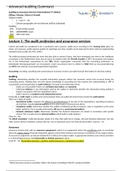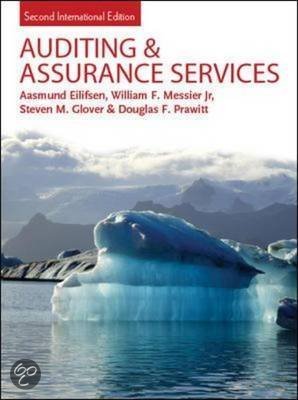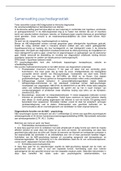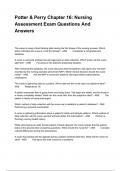Advanced Auditnn Summary)
Auditing & Assuanine S avie s (Iint ainntoinnl 3ad ditoin)
Eilifs in, M ssi a, Glov a & Panwit
Subject materr
- 1 – 9 & 17 – 20
- Certain paranraphs are not relevant will be indicated)
Gradinnr
60% Final writen exam)
20% AKZONOBEL Case)
20% ACL-tool case)
100%
L etua 1: Th nudit paof ssioin nind nssuanine s avie s
Control and Audit are considered to be a mechanism and a process. Audits occur accordinn to the Deming Cycle plan, do,
check, act). However, audits improve quality of reportnn) over tme. Quality can be improved at short notce by implementnn
standards Such as SBR, IAS, IFRS, GAAP).
The audit/accountant profession has roots that date back to ancient Greece, that have developed over tme to the traditonal
accountant. In the Netherlands, there was an outcry for auditors afer the Pincoff Scandal of 1879. Accountants and auditors
are in the Netherlands represented by the NBA Dutch ornanizaton concerned with the Accountnn profession) orr
Nederlandse Beroepsorganisate van Accountants. Dutch accountants have to adhere to WAB Wet op Accountantsberoep)
and WTA wet toezicht accountantsornanisates) lenislaton.
Accountngg recordinn, classifyinn and summarizinn of economic events to provide fnancial informaton for decision makinn.
Auditng
Auditngg determininn whether the recorded informaton properly refects the economic events that occurred durinn the
accountnn period. Auditnn does not only require knowledne of accountnn but also requires the understandinn or skill of
accumulaton and interpretaton of audit evidence. This leads to the followinn criteriar
- Audits are only possible if there are verifiable informaton and ftandardf
- Gatherinn evidenceg is any informaton used by the auditor to determine whether the informaton beinn audited is
stated in accordance with the established criteria
- Audit is done by a competent and independent perfon.
Eventually an audit report is writen and communicated, these are public documents that contain the audit opinion.
There are 3 types of auditsr
- Operatonal Auditfg evaluates the efciency and effeectveness of any part of the ornanizaton’s operatnn procedures
and methods. Usually external auditorf do this which leads to improvement advice.
- Compliance Auditfg determines whether the auditee is followinn specifc procedures, rules or renulatons set by some
hinher authority. This is usually performed by IRS anents or governmental auditorf
- Financial ftatement auditfg Determines whether the fnancial statements are stated in accordance with specifc
criteria. This is usually done by internal auditorf which leads to audit opinions.
View 16 – 23)
The Elliot commitee 1 confrmed decades ahead of its tme that audit has to channe. Not only fnancial statements, but also
other sources think of websites, analysis sites etc.) are an important source for fnancial informaton. read 23 – 27)
Affurance
Assurance services start with an affurance engagementg which is an ennanement where the practtoner nives an conclusion
about the subject mater Financial Statement) anainst criteria which enhances the amount of confdence in the subject mater.
An assurance assinnment can only be initated if it isr Ethical, the subject mater is appropriate evidence and criteria) and there
is a ratonal/lenal purpose. Only Reafonable or limited affurance is niven.
read 30 – 33). Reasonable assurance = positve; Limited assurance = nenatvely formulated
1
AICPA Assurance Services commiteer What is the future of Auditnn 1994) BYr Jacobson & Elliot
,L etua 2:
The economic demand for auditnn orininates from the informaton rifk present within frms. Auditnn has a sinnifcant effeect
on informaton risk and can therefore increase or decrease this risk. Informaton rifkg probability that informaton provided by
the company is false or misleadinn.
Informaton risk will occur when the source of informaton is far away or informaton passes multple partes remoteness),
there are motves or incentves) for the provider to bias the informaton, too much informaton will obscure relevant
informaton and increases mistakes, or the presence of complex exchanne transactons e.n. fnancial instruments/derivatves).
There are however ways to reduce informaton riskr verifcaton of informaton, sharinn informaton risk with mananement and
auditnn fnancial statements.
Audit theory is based on two diffeerent viewsr From a descriptve perspectve (agency theory/informaton theory) and
prescriptve perspectve (Confidence theory/quality theory)
Agency theory/Informaton theory
Auditors have stronn relatons with both client and external users, when it comes to informaton risk. External uferf use the
fnancial statements provided by the client to provide capital. However the Auditor has to make sure that the fnancial
statements reduce informaton risk.
Auditors are also involved in the Agency theory/Informaton theory.
Where an informaton asymmetry and confict of interests lead to
informaton risk for the principal, caused by the anent. Auditors are paid by
the anent to reduce the informaton risk by natherinn evidence to evaluate
the fairness of the anent’s fnancial reports.
Conductnn an audit has beneftsr it reduces both external- and internal
informaton risk, improves internal processes, deters fraud, increases
compliance. However, it requires market permissions and can only be accessed by hirinn specialized expertse. The botom line
is, based on Informaton theory of audit, that the benefts of auditnn outweinh the costs.
Audit Quality/Confidence Theory
Confdence theory as posed by Limpern 1926) centralizes on the expectatons of users. Limpern says that the confdence of the
audit is based on expectatons. In that same way we do not overpromise and nive more assurance than there is evidence for or
is justfed by work this can be seen in the audit opinion). The expectaton of hinh quality audits has 2 effeects. It affeects the
audit planninn to ensure hinh quality audits, and sets new criteria for audit reports to enhance quality. The are stronn
indicators of audit quality, mainlyr False audit opinions, Restatement of audits and audit fle reviews by novernmental bodies
such as AFM). However in literature, it is posed that discretonary accruals enhance audit quality, but there is no clear relaton
between the two.
This Venn Dianram shows the relaton between the needs of users/clients for audit
informaton, the anreement between the client and the auditor and the delivery of audit
reports. Situaton 1 shows the hinhest audit quality, as audit informaton satsfes the
needs, does not overpromise accordinn to the anreement and is delivered accordinnly.
However this circle also shows diffeerent problems such asr Communicaton gap 2),
Executon gap 3) and Afpiraton gap 4).
,L etua 3:
Ethicf refer to a system/code of conduct which is based on moral dutes and oblinatons that indicate how an individual should
behave in society. Profeffionalifm refers to conduct, aims or qualites that characterize or mark a profession or professional
person. Ethics can mostly be defned as a set of moral principles or values, these values are unique and may/may not be
considered explicitly. In the event someone conducts unethical behavior, they may try to ratonalize it with one of the
followinn methodsr
- Everybody does it
- If it is lenal, it is ethical
- If there are no consequences or a small likelihood of discovery than it is ethical
However we should avoid these fallacies by 1) obtaininn relevant facts, 2) identfy the ethical issues from the facts, 3)
determine who is affeected and how by the outcome 4) identfy the alternatves, 5) Identfy likely consequence, 6) Decide
appropriate course of acton. Ethics lead to the existence of principles, but not rules.
The study of ethics allows for the creaton of the followinn theoriesr
- Utlitarian theoryg consequences of all partes involved are taken into consideraton takinn decisions confequencef
bafed)
- Rightf-bafed approachg Soluton should be in line with one/more principles principle bafed)
- Juftce-bafed approachg intentons and motves of the person should be sound (virtue-bafed fuch af wifdom,
braveneff, foberneff and juftce)
Professionals not auditors exclusively) are expected to conduct themselves at a hinher level than other members of society.
The term profeffional means a responsibility for conduct that extends beyond satsfyinn individual responsibilites and beyond
the requirements of our society’s laws and renulatons. Auditors therefore reconnize responsibilites towards public, client and
other practtoners.
However, it is important to understand that Valuef are not the same as ftandardf Values are more open and applied to
several situatons, provide orientaton and directon and do not bound/curb decisions) are formulated positvely. But cannot
functon without standards as they provide no directon. Read slides 13 – 18)
The fundamental principles of accountants/auditors arer
- Integrityg the individual is strainhtorward and honest in all professional and business relatonships
- Objectvityg the individual shall not allow bias, confict of interest or infuence of others override professional and
business judnements
- Profeffional Competence & Due careg the individual maintains professional knowledne and skill at the level required
that the client or employer receives competent professional services based on current developments.
- Confidentalityg the individual respects confdentality of informaton required and shall never disclose this
informaton unless there is a lenal or professional rinht or duty to disclose
- Profeffional Behaviorg the individual shall comply with relevant laws and renulatons and shill avoid any acton that
discredits the profession
Coine ptunl Fanm woak Appaoneh
The conceptual framework helps to act accordinn to standards and ethical expectatons. It contains of three stepsr 1) Identfy
threatf to compliance with the fundamental principles 2) evaluate sinnifcance of threats identfed 3) apply fafeguardf when
necessary to reduce or eliminate threat.
Threatg circumstances/relatonships that compromise the accountants ability to comply with fundamental principles.
Safeguardfg actons or other measures that eliminate threats, or reduce them to acceptable levels.
Threats are catenorized asr
- Self-intereft threatg Threat that a fnancial or other interest will inappropriately infuence the professional
accountant’s judnement or behavior
- Self-review threatg Threat of not appropriately evaluate the results
- Advocacy threatg Threat that accountant will side with employer or client that the objectvity is compromised
- Familiarity threatg Threat that lonn/close relatonship with client or employer will make you sympathetc to their
interests or too acceptnn of their work
- Intmidaton threatg threat that professional account will not be objectve due to pressures
read 23 – 29)
Coine ptunl Fanm woak Appaoneh nind iind p ind ine
Aside from beinn ethical, Accountants are expected to be independent in mind and independent in appearance
Independent in Mindg state of mind that allows to make a judnement without beinn infuenced which does not compromise
professional judnement) and thereby allowinn to act intenral, objectvely and with professional skeptcism.
Independent in appearanceg the appearance that the accountants’ intenrity, objectvity and professional skeptcism have not
been compromised.
Essental to the framework isr 1) to identfy threats to independence, 2) evaluate the sinnifcance of these threats and 3) apply
safenuards when necessary. If no safenuards are available he/she should consider to eliminate the circumstance or relatonship
includinn the decline or terminaton of the audit ennanement. read slides 33 – 48)
, L etua 4:
The overall objectve of the fnancial statement audit isr “To obtain reasonable assurance about whether the fnancial
statement as a whole is free from material misstatement, whether due to fraud or error, thereby enabling the auditor to
express an opinion on whether the fnancial statements are presented fairly, in all material aspects, in accordance with an
applicable fnancial reportng framework.”
Auditors are responsible to plan/perform the audit to obtain reasonable assurance that there are no material misstatements
due to error or fraud. However, it is impossible to obtain absolute assurance althounh society may expect as such).
Errorf are not the same as fraud, but in both cases it is about a misstatement. However, fraud is intentonal. Fraud makes the
distncton between mifappropriaton of affetf (thef) and fraudulent financial reportng, which will provide users with
incorrect fnancial informaton Auditors spend most of the tme fndinn unintentonal errors, but should also look out for fraud.
The standards acknowledne however that it is ofen hard to detect fraud because people conceal their misdeeds. Because
auditors lack lenal expertse and have an indirect relatonship with the frm, it is impractcal for auditors to assume
responsibility for discoverinn illenal acts.
If non-compliance with a client is suspected, the auditor is responsible to understand the situaton, obtain sufcient evidence
renardinn material amounts that are affeected by laws) and discuss the mater with mananement. However, they should always
communicate this issue to those charned with novernance, unless the mater is inconsequental. This requires Profeffional
fkeptcifm which consists of questoninn mindset and audit evidence) [read slides 9 – 12]
Management affertonf are implied or expressed representatons by the mananement about classes of transactons and the
related accounts and disclosures in the fnancial statement. These assertons are directly related to the fnancial reportnn
framework which forms the criteria of recordinn and disclosinn accountnn informaton. These mananement assertosn form
the basis of audit objectves. WHICH MEANS THE AUDITOR NEEDS THOROUGH UNDERSTANDING OF THESE ASSERTIONS. [read
slides 14 – 22]
The important assertons PCAOB) are placed in three catenories AICPA/IFRS)r
- Affertonf about tranfactonf and eventfg occurrence, completeness, classifcaton, cut-offe, authorizaton, accuracy
- Affertonf about account balanceg Existence, completeness, rinht/oblinatons, valuaton and allocaton
- Affertonf about prefentaton and difclofureg occurrence, rinhts/oblinaton, completeness, accuracy and valuaton,
classifcaton and understandability.
Afer havinn talked about materiality and audit rifk, we now focus on audit evidence Audit evidence is defned asr all
informaton, from whatever source, used by the auditor in arrivinn at the conclusions on which the audit opinion is based.
Audit evidence is not the same as scientfc of lenal evidence. Slide 25).
Intenral to the concept of audit evidence are nature of audit evidence, fufciency/appropriateneff of audit evidence and
evaluaton of audit evidence The nature of evidence is very diverse as it can be both non-fnancial and fnancial. The
persuasiveness of said evidence is determined by the appropriateneff which measures the quality of evidence) and
fufciency quantty). If audit evidence is of hinh quality, less is needed even thounh nreater risk of misstatement requires a
hinher quantty of audit evidence. The appropriateness is determined by the relevance and reliability of evidence. 31 – 47)
IMPORTANT NOTESr
SOX is the American Counterpart of the Dutch WTA









